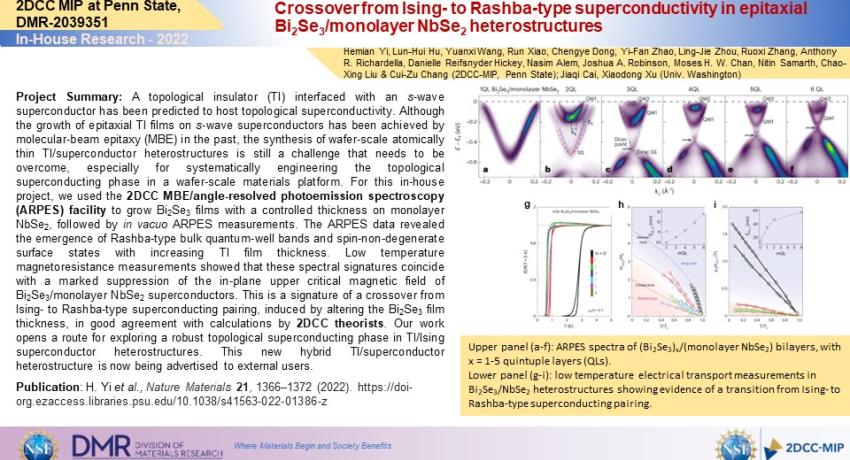Project Summary: A topological insulator (TI) interfaced with an s-wave superconductor has been predicted to host topological superconductivity. Although the growth of epitaxial TI films on s-wave superconductors has been achieved by molecular-beam epitaxy (MBE) in the past, the synthesis of wafer-scale atomically thin TI/superconductor heterostructures is still a challenge that needs to be overcome, especially for systematically engineering the topological superconducting phase in a wafer-scale materials platform. For this in-house project, we used the 2DCC MBE/angle-resolved photoemission spectroscopy (ARPES) facility to grow Bi2Se3 films with a controlled thickness on monolayer NbSe2, followed by in vacuo ARPES measurements. The ARPES data revealed the emergence of Rashba-type bulk quantum-well bands and spin-non-degenerate surface states with increasing TI film thickness. Low temperature magnetoresistance measurements showed that these spectral signatures coincide with a marked suppression of the in-plane upper critical magnetic field of Bi2Se3/monolayer NbSe2 superconductors. This is a signature of a crossover from Ising- to Rashba-type superconducting pairing, induced by altering the Bi2Se3 film thickness, in good agreement with calculations by 2DCC theorists. Our work opens a route for exploring a robust topological superconducting phase in TI/Ising superconductor heterostructures. This new hybrid TI/superconductor heterostructure is now being advertised to external users.
Publication: H. Yi et al., Nature Materials 21, 1366–1372 (2022). https://doi-org.ezaccess.libraries.psu.edu/10.1038/s41563-022-01386-z
What Has Been Achieved: We developed MBE growth of a new hybrid vdW topological insulator (TI)/2D superconductor (SC) quantum material by interfacing a 2D SC (monolayer NbSe2) epitaxially with a canonical TO (Bi2Se3). We demonstrated a transition from Ising- to Rashba-like pairing in the SC.
Importance of the Achievement: This work is an important step toward developing a wafer scale topological superconductor platform for topological quantum computing.
Unique Feature(s) of the MIP that Enabled this Achievement: the 2DCC MBE/ARPES and theory facilities were essential for obtaining a comprehensive understanding of this new family of heterostructures.
(If Applicable) Publication:
Hemian Yi, Lun-Hui Hu, Yuanxi Wang, Run Xiao, Jiaqi Cai, Danielle Reifsnyder Hickey, Chengye Dong, Yi-Fan Zhao, Ling-Jie Zhou, Ruoxi Zhang, Anthony R. Richardella, Nasim Alem, Joshua A. Robinson, Moses H. W. Chan, Xiaodong Xu, Nitin Samarth, Chao-Xing Liu & Cui-Zu Chang
Crossover from Ising- to Rashba-type superconductivity in epitaxial Bi2Se3/monolayer NbSe2 heterostructures. Nat. Mater. 21, 1366–1372 (2022). https://doi-org.ezaccess.libraries.psu.edu/10.1038/s41563-022-01386-z.
Acknowledgments: This work is primarily supported by the Penn State MRSEC for Nanoscale Science (DMR-2011839) (H.Y. and C.-Z.C.). The electrical transport measurements and sample characterization are partially supported by the NSF CAREER award (DMR-1847811) (C.-Z.C.). The theoretical calculations and simulations are partially supported by a DOE grant (DE-SC0019064) (C.-X.L.). Y.W. acknowledges support from a startup grant from the University of North Texas. The MBE growth and ARPES measurements were performed in the NSF-supported 2DCC MIP facility (DMR-2039351) (N.S. and C.-Z.C.). The dilution refrigerator transport measurements at University of Washington are supported by the AFOSR award (FA9550-21-1-0177) (X.X.) and acknowledge the usage of the millikelvin optoelectronic quantum material laboratory supported by the M. J. Murdock Charitable Trust. D.R.H. and N.A. acknowledge support from the NSF CAREER award (DMR-1654107). C.-Z.C. also acknowledges support from the Gordon and Betty Moore Foundation’s EPiQS Initiative (grant GBMF9063 to C.-Z.C.).
